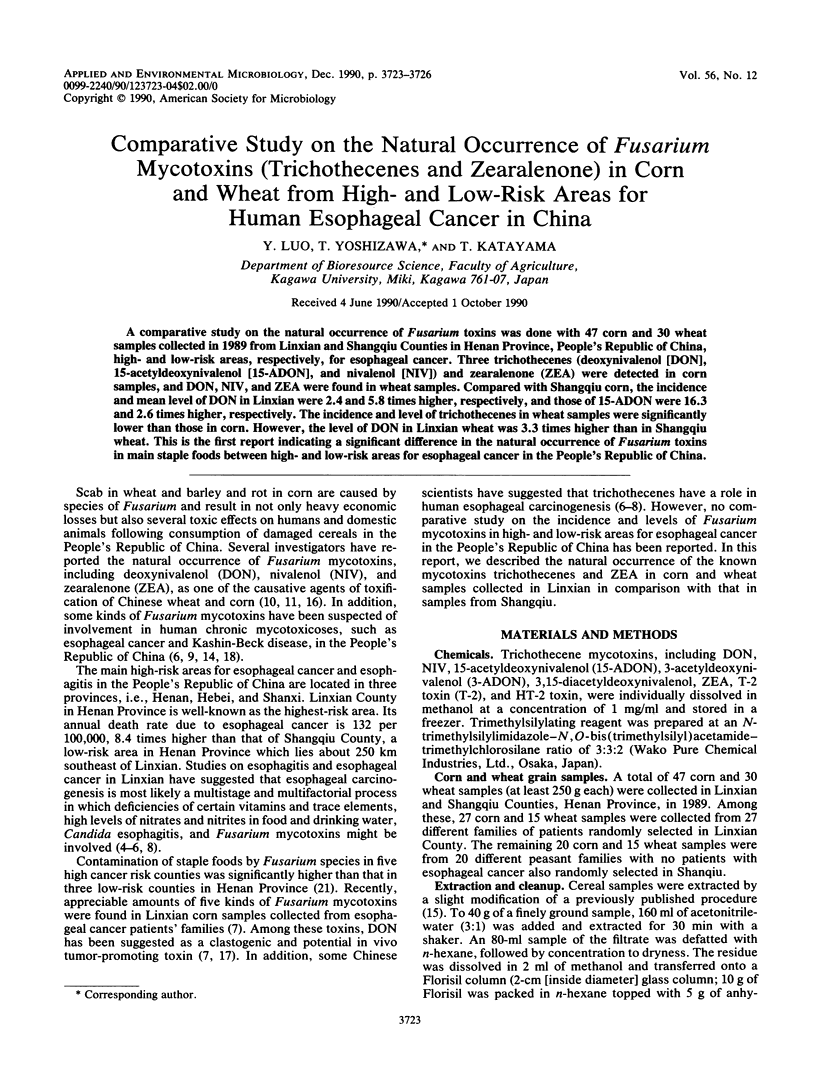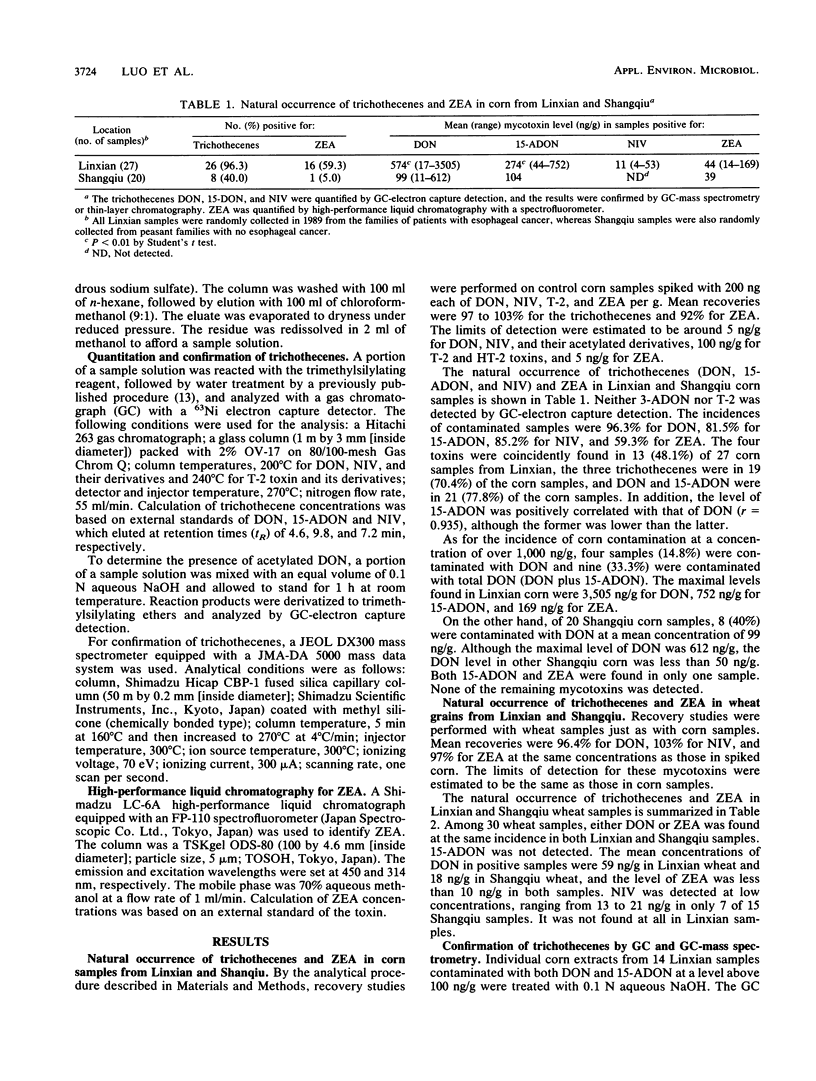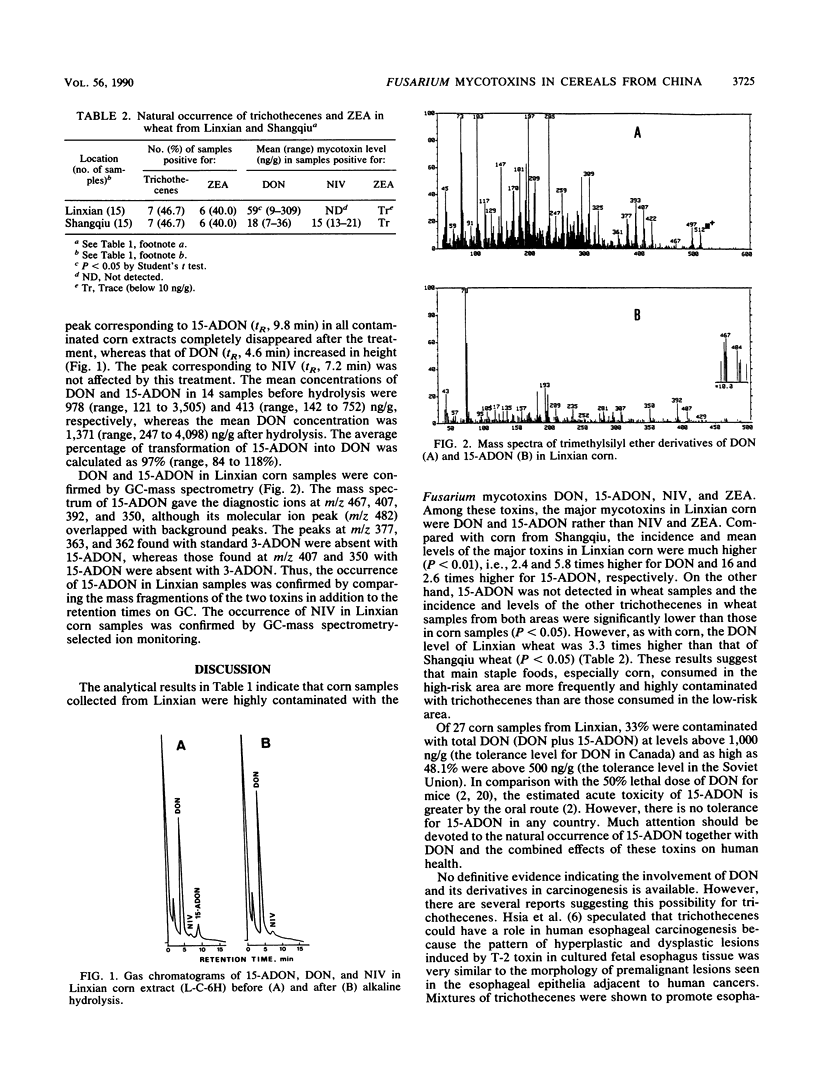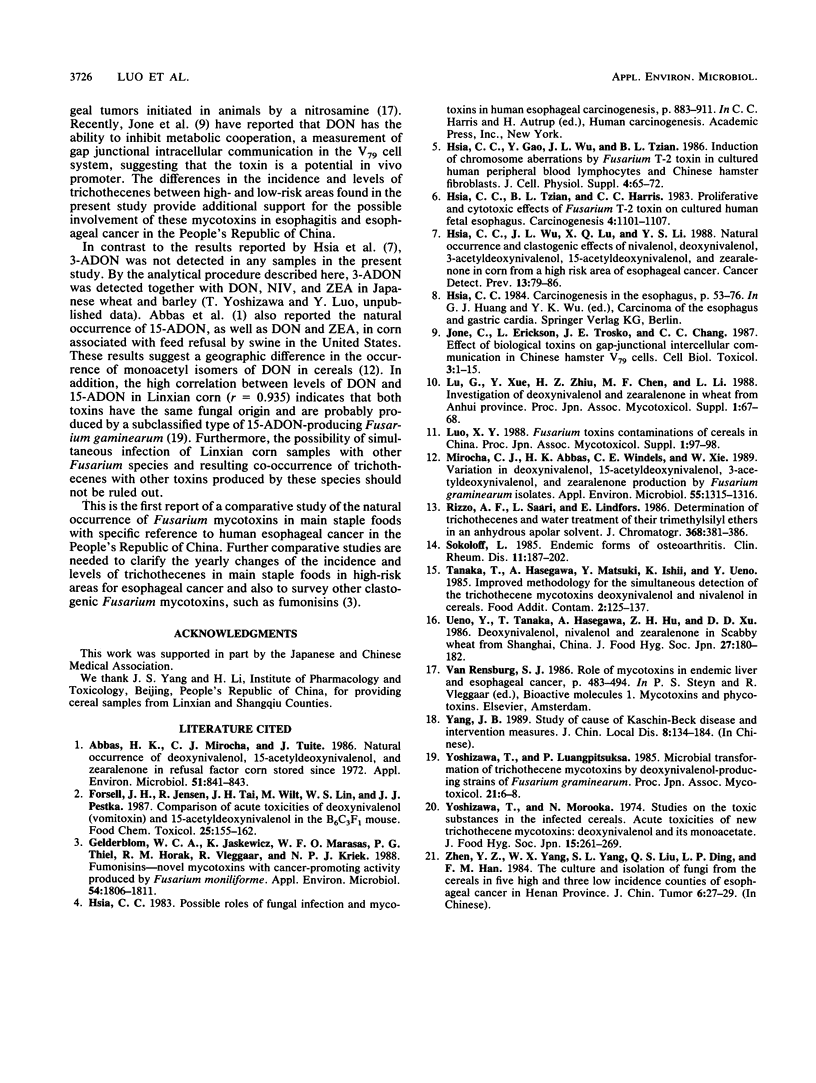Abstract
A comparative study on the natural occurrence of Fusarium toxins was done with 47 corn and 30 wheat samples collected in 1989 from Linxian and Shangqiu Counties in Henan Province, People's Republic of China, high- and low-risk areas, respectively, for esophageal cancer. Three trichothecenes (deoxynivalenol [DON], 15-acetyldeoxynivalenol [15-ADON], and nivalenol [NIV]) and zearalenone (ZEA) were detected in corn samples, and DON, NIV, and ZEA were found in wheat samples. Compared with Shangqiu corn, the incidence and mean level of DON in Linxian were 2.4 and 5.8 times higher, respectively, and those of 15-ADON were 16.3 and 2.6 times higher, respectively. The incidence and level of trichothecenes in wheat samples were significantly lower than those in corn. However, the level of DON in Linxian wheat was 3.3 times higher than in Shangqiu wheat. This is the first report indicating a significant difference in the natural occurrence of Fusarium toxins in main staple foods between high- and low-risk areas for esophageal cancer in the People's Republic of China.
Full text
PDF



Selected References
These references are in PubMed. This may not be the complete list of references from this article.
- Abbas H. K., Mirocha C. J., Tuite J. Natural occurrence of deoxynivalenol, 15-acetyl-deoxynivalenol, and zearalenone in refusal factor corn stored since 1972. Appl Environ Microbiol. 1986 Apr;51(4):841–843. doi: 10.1128/aem.51.4.841-843.1986. [DOI] [PMC free article] [PubMed] [Google Scholar]
- Forsell J. H., Jensen R., Tai J. H., Witt M., Lin W. S., Pestka J. J. Comparison of acute toxicities of deoxynivalenol (vomitoxin) and 15-acetyldeoxynivalenol in the B6C3F1 mouse. Food Chem Toxicol. 1987 Feb;25(2):155–162. doi: 10.1016/0278-6915(87)90149-9. [DOI] [PubMed] [Google Scholar]
- Gelderblom W. C., Jaskiewicz K., Marasas W. F., Thiel P. G., Horak R. M., Vleggaar R., Kriek N. P. Fumonisins--novel mycotoxins with cancer-promoting activity produced by Fusarium moniliforme. Appl Environ Microbiol. 1988 Jul;54(7):1806–1811. doi: 10.1128/aem.54.7.1806-1811.1988. [DOI] [PMC free article] [PubMed] [Google Scholar]
- Hsia C. C., Gao Y., Wu J. L., Tzian B. L. Induction of chromosome aberrations by fusarium T-2 toxin in cultured human peripheral blood lymphocytes and Chinese hamster fibroblasts. J Cell Physiol Suppl. 1986;4:65–72. doi: 10.1002/jcp.1041290413. [DOI] [PubMed] [Google Scholar]
- Hsia C. C., Tzian B. L., Harris C. C. Proliferative and cytotoxic effects of Fusarium T2 toxin on cultured human fetal esophagus. Carcinogenesis. 1983 Sep;4(9):1101–1107. doi: 10.1093/carcin/4.9.1101. [DOI] [PubMed] [Google Scholar]
- Hsia C. C., Wu J. L., Lu X. Q., Li Y. S. Natural occurrence and clastogenic effects of nivalenol, deoxynivalenol, 3-acetyl-deoxynivalenol, 15-acetyl-deoxynivalenol, and zearalenone in corn from a high-risk area of esophageal cancer. Cancer Detect Prev. 1988;13(2):79–86. [PubMed] [Google Scholar]
- Jone C., Erickson L., Trosko J. E., Chang C. C. Effect of biological toxins on gap-junctional intercellular communication in Chinese hamster V79 cells. Cell Biol Toxicol. 1987 Mar;3(1):1–15. doi: 10.1007/BF00117821. [DOI] [PubMed] [Google Scholar]
- Mirocha C. J., Abbas H. K., Windels C. E., Xie W. Variation in Deoxynivalenol, 15-Acetyldeoxynivalenol, 3-Acetyldeoxynivalenol, and Zearalenone Production by Fusarium graminearum Isolates. Appl Environ Microbiol. 1989 May;55(5):1315–1316. doi: 10.1128/aem.55.5.1315-1316.1989. [DOI] [PMC free article] [PubMed] [Google Scholar]
- Sokoloff L. Endemic forms of osteoarthritis. Clin Rheum Dis. 1985 Aug;11(2):187–202. [PubMed] [Google Scholar]
- Tanaka T., Hasegawa A., Matsuki Y., Ishii K., Ueno Y. Improved methodology for the simultaneous detection of the trichothecene mycotoxins deoxynivalenol and nivalenol in cereals. Food Addit Contam. 1985 Apr-Jun;2(2):125–137. doi: 10.1080/02652038509373534. [DOI] [PubMed] [Google Scholar]
- Zhen Y. Z. [Isolation and culture of fungi from the cereals in counties of Henan Province--5 with high and 3 with low incidences of esophageal cancer]. Zhonghua Zhong Liu Za Zhi. 1984 Jan;6(1):27–29. [PubMed] [Google Scholar]


